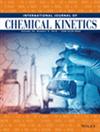Kinetic modeling and isotherm approach for biosorptive removal of hexavalent chromium using heat inactivated fungal biomass
IF 1.6
4区 化学
Q4 CHEMISTRY, PHYSICAL
引用次数: 1
Abstract
Two highly Cr (VI) resistant fungal strains, CSF-1 and CSF-2, were isolated and identified as Cladosporium sp. and Penicillium sp., respectively, using 18S rRNA gene sequencing. At optimized growth conditions, the dead biomass of Cladosporium sp. and Penicillium sp. has removed more than 99% of the supplemented Cr(VI). The kinetic study outcomes evidenced that the present fungal Cr(VI) biosorption is best fitting with the pseudo-first-order model with higher R2 values (i.e., 0.70–0.95) than that of the pseudo-second-order kinetic model (R2 = 0.02–0.73). After analyzing the R2 values, it was observed that the Langmuir and Freundlich isotherm models best fit the Cr(VI) biosorption employing fungal biomass.
热灭活真菌生物量吸附去除六价铬的动力学模型和等温线方法
分离到2株高Cr (VI)抗性真菌CSF-1和CSF-2,经18S rRNA基因测序鉴定分别为Cladosporium sp.和Penicillium sp.。在优化的生长条件下,枝孢菌和青霉菌的死生物量对添加的Cr(VI)的去除率达到99%以上。动力学研究结果表明,目前真菌对Cr(VI)的生物吸附最符合拟一阶模型,其R2值(0.70 ~ 0.95)高于拟二阶动力学模型(R2 = 0.02 ~ 0.73)。通过对R2值的分析,发现Langmuir和Freundlich等温线模型最适合真菌生物量对Cr(VI)的生物吸附。
本文章由计算机程序翻译,如有差异,请以英文原文为准。
求助全文
约1分钟内获得全文
求助全文
来源期刊
CiteScore
3.30
自引率
6.70%
发文量
74
审稿时长
3 months
期刊介绍:
As the leading archival journal devoted exclusively to chemical kinetics, the International Journal of Chemical Kinetics publishes original research in gas phase, condensed phase, and polymer reaction kinetics, as well as biochemical and surface kinetics. The Journal seeks to be the primary archive for careful experimental measurements of reaction kinetics, in both simple and complex systems. The Journal also presents new developments in applied theoretical kinetics and publishes large kinetic models, and the algorithms and estimates used in these models. These include methods for handling the large reaction networks important in biochemistry, catalysis, and free radical chemistry. In addition, the Journal explores such topics as the quantitative relationships between molecular structure and chemical reactivity, organic/inorganic chemistry and reaction mechanisms, and the reactive chemistry at interfaces.

 求助内容:
求助内容: 应助结果提醒方式:
应助结果提醒方式:


